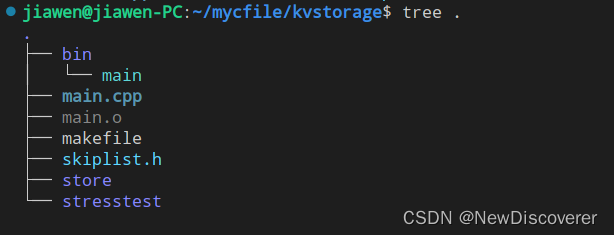-
gdb结合valgrind一起使用
一、简介
这篇文章使我学习gdb与valgrind一起使用的记录
二、gdb和valgrind结合使用
这个是一个例子Use Valgrind, GDB, and vgdb to debug | Red Hat Developer 里面有个简单的示例,这个示例让我看到这个工具挺强大的。
下面使我代码的结构

makefile中,记得启用调试选项。
在一个终端输入:
valgrind -q --vgdb-error=0 ./main //成功运行后,会显示pid号
在另一个终端输入:
gdb ./main
成功后
再输入target remote | vgdb --pid=***
现在,你就可以愉快的调试了。
在gdb端,运行,可以看到valgrind 的一些监视器的一些命令

具体是:
- general valgrind monitor commands:
- help [debug] : monitor command help. With debug: + debugging commands
- v.wait [<ms>] : sleep <ms> (default 0) then continue
- v.info all_errors : show all errors found so far
- v.info last_error : show last error found
- v.info location <addr> : show information about location <addr>
- v.info n_errs_found [msg] : show the nr of errors found so far and the given msg
- v.info open_fds : show open file descriptors (only if --track-fds=yes)
- v.kill : kill the Valgrind process
- v.set gdb_output : set valgrind output to gdb
- v.set log_output : set valgrind output to log
- v.set mixed_output : set valgrind output to log, interactive output to gdb
- v.set merge-recursive-frames <num> : merge recursive calls in max <num> frames
- v.set vgdb-error <errornr> : debug me at error >= <errornr>
- memcheck monitor commands:
- xb <addr> [<len>]
- prints validity bits for <len> (or 1) bytes at <addr>
- bit values 0 = valid, 1 = invalid, __ = unaddressable byte
- Then prints the bytes values below the corresponding validity bits
- in a layout similar to the gdb command 'x /
xb ' - Example: xb 0x8049c78 10
- get_vbits <addr> [<len>]
- Similar to xb, but only prints the validity bytes by group of 4.
- make_memory [noaccess|undefined
- |defined|Definedifaddressable] <addr> [<len>]
- mark <len> (or 1) bytes at <addr> with the given accessibility
- check_memory [addressable|defined] <addr> [<len>]
- check that <len> (or 1) bytes at <addr> have the given accessibility
- and outputs a description of <addr>
- leak_check [full*|summary|xtleak]
- [kinds kind1,kind2,...|reachable|possibleleak*|definiteleak]
- [heuristics heur1,heur2,...]
- [increased*|changed|any]
- [unlimited*|limited <max_loss_records_output>]
- * = defaults
- xtleak produces an xtree full leak result in xtleak.kcg.%p.%n
- where kind is one of:
- definite indirect possible reachable all none
- where heur is one of:
- stdstring length64 newarray multipleinheritance all none*
- Examples: leak_check
- leak_check summary any
- leak_check full kinds indirect,possible
- leak_check full reachable any limited 100
- block_list <loss_record_nr>|<loss_record_nr_from>..<loss_record_nr_to>
- [unlimited*|limited <max_blocks>]
- [heuristics heur1,heur2,...]
- after a leak search, shows the list of blocks of <loss_record_nr>
- (or of the range <loss_record_nr_from>..<loss_record_nr_to>).
- With heuristics, only shows the blocks found via heur1,heur2,...
- * = defaults
- who_points_at <addr> [<len>]
- shows places pointing inside <len> (default 1) bytes at <addr>
- (with len 1, only shows "start pointers" pointing exactly to <addr>,
- with len > 1, will also show "interior pointers")
- xtmemory [<filename>]
- dump xtree memory profile in <filename> (default xtmemory.kcg.%p.%n)
- 给我解释一下,仔细的解释
使用方式,比如:
monitor v.info last_error
-
相关阅读:
机器人控制算法——TEB算法—Obstacle Avoidance and Robot Footprint Model(避障与机器人足迹模型)
基于MATLAB的函数拟合
在家自己动手修电视解决屏幕跳动问题
Vue基础知识——数据绑定、数据代理
Java中SpringBoot四大核心组件是什么
秦皇岛2020CCPC补题
计算机毕业设计Java教学视频平台系统(源码+系统+mysql数据库+lw文档)
LabVIEW使用PID对激振器控制
No matching version found for zr-map-ol@1.1.19.
什么?MySQL 8.0 会同时修改两个ib_logfilesN 文件?
- 原文地址:https://blog.csdn.net/weixin_46430043/article/details/132561206
